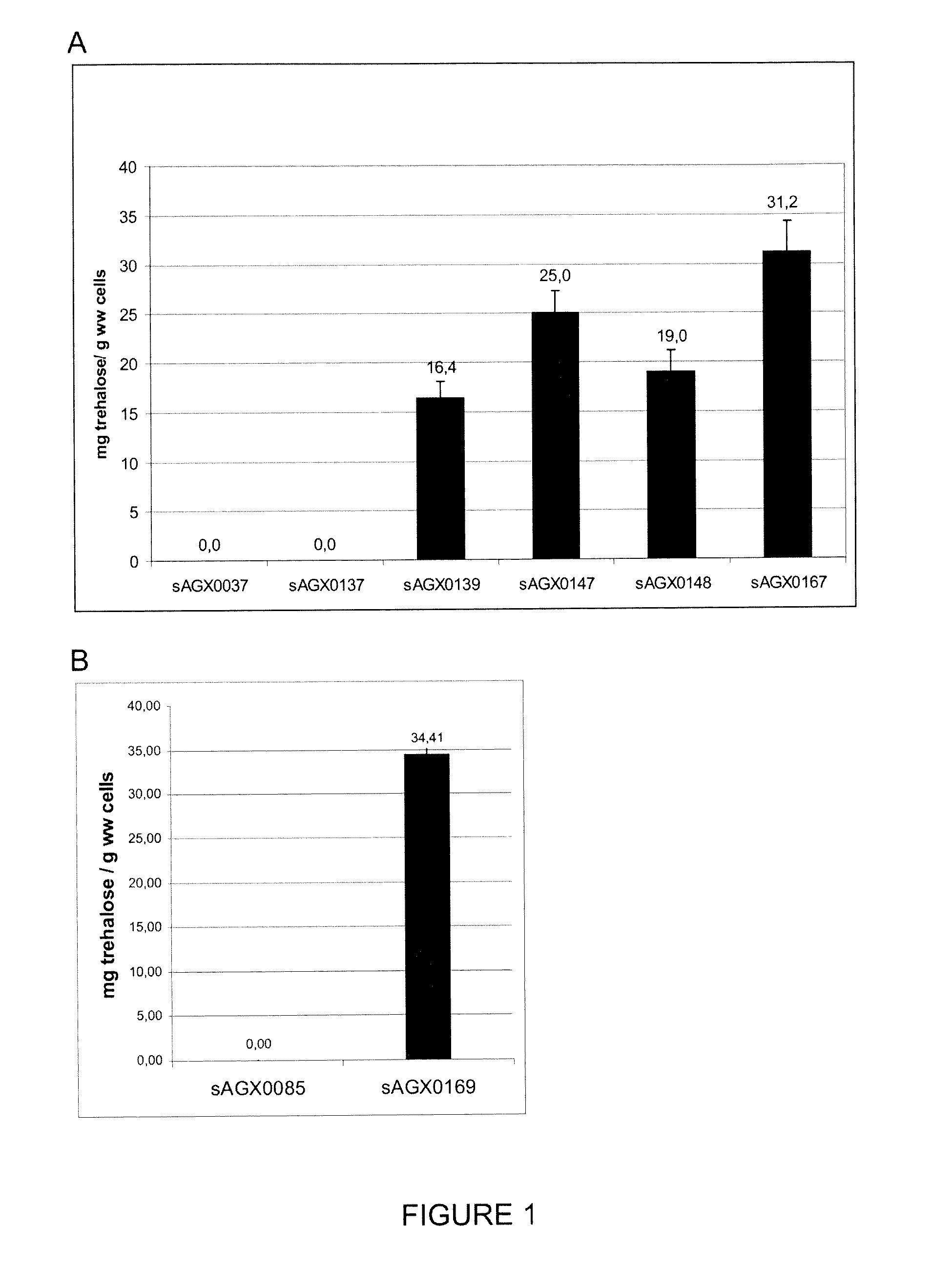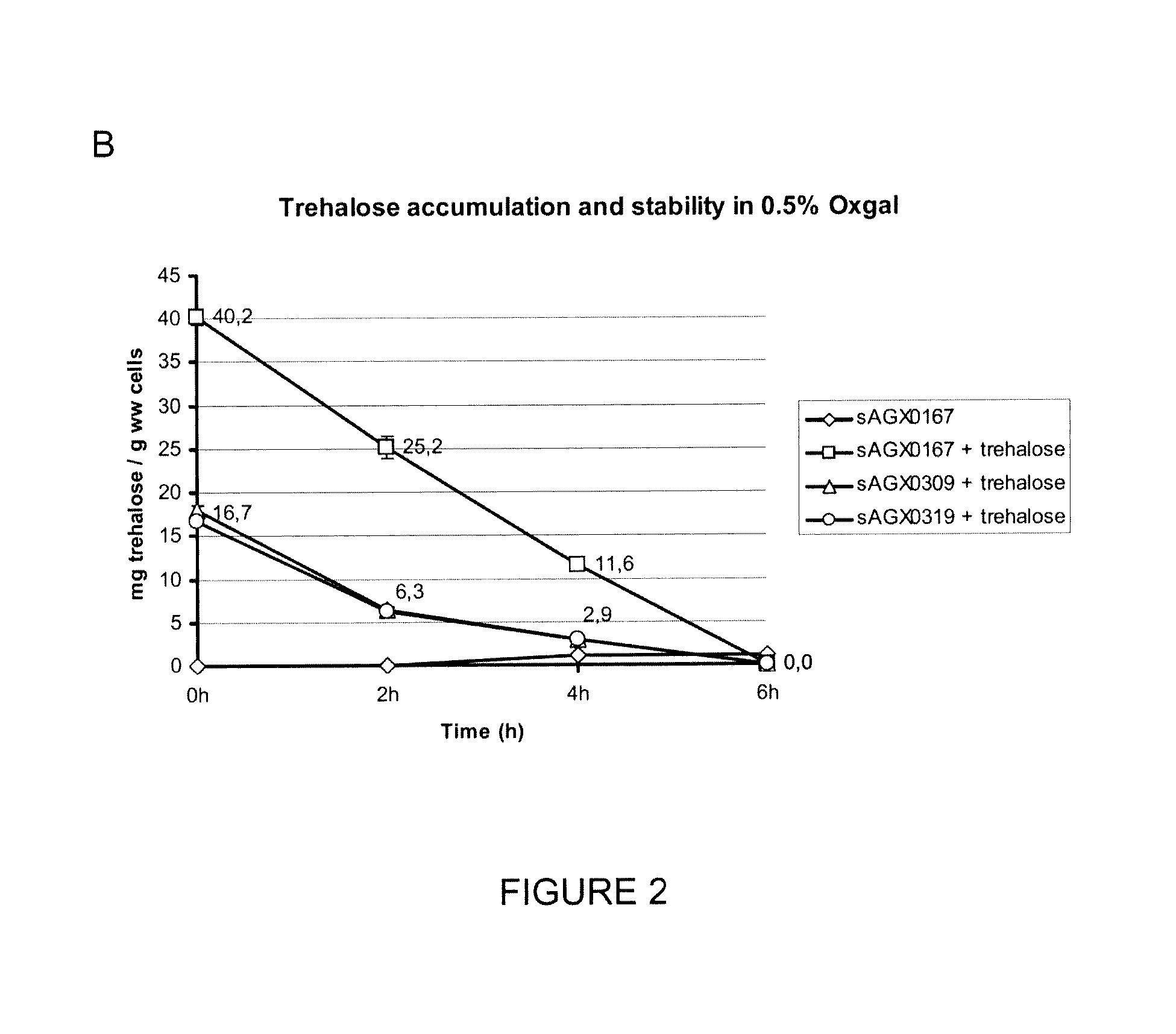Modified gram positive bacteria and uses thereof
a technology of gram positive bacteria and gram positive bacteria, which is applied in the field of microorganisms, can solve the problems of limited number of approaches, no trehalose synthesizing i>lactococcus lactis , no trehalose synthesizing
- Summary
- Abstract
- Description
- Claims
- Application Information
AI Technical Summary
Benefits of technology
Problems solved by technology
Method used
Image
Examples
example 1
Intracellular Trehalose Accumulation Following trePP Inactivation
Experimental
[0185]Strains were grown overnight (A) or for 24 hours (B) in 50 ml GM17T+500 mM trehalose at 30° C., cells were collected by centrifugation and trehalose content was determined: equivalents of 10 ml overnight culture were washed 3 times with 0.25 M carbonate buffer where after weight of the cell pellet (wet weight) was determined. Cells were lysed in 1 ml 0.25 M carbonate buffer using the lysing matrix B and the MP Fasprep-24 device at 6 m / s for 40 seconds (MP Biomedicals). Supernatant of the lysed cells was separated by centrifugation and heated for 30 minutes at 99° C. Cell debris was removed by centrifugation and the supernatant was assayed for trehalose concentration using a trehalose assay kit (K-TREH 010 / 10, Megazyme, Ireland). Briefly, trehalose in the samples is hydrolysed to D-glucose by trehalase, and the D-glucose released is phosphorylated by the enzyme hexokinase and adenosine-5′ triphoshate (...
example 2
The Accumulation of Exogenous Trehalose Provides Protection Towards Bile Lysis
Experimental
[0188]Strains were grown overnight in 50 ml GM17T or GM17T+500 mM trehalose at 30° C., cells were collected by centrifugation and resuspended in 25 ml 0.9% NaCl. Samples were taken and CFU were determined by plating appropriate dilutions (initial) At T0, 25 ml 1% oxgal in 0.9% NaCl was added and cell suspensions were incubated for 8 h at 37° C. Samples were taken at T0, 1, 2, 4, 6 and 8 h. CFU were determined by plating appropriate dilutions (FIG. 2 A), trehalose content was determined (FIG. 2 B) essentially as described in Example 1
Results
[0189]Intracellular trehalose protects against bile lysis and the loss of intracellular trehalose coincides with decreased resistance to bile lysis. Therefore, leakage of trehalose is problematic for long term stability in bile.
[0190]Indicated in FIG. 2 is that the accumulation of exogenous trehalose in L. lactis cells provides protection towards bile lysis. ...
example 3
The Accumulation of Exogenous Trehalose in Provides Protection Towards Bile Lysis
Experimental
[0191]Cells were collected by centrifugation and resuspended in 1×M9 salts solution. Samples were taken and trehalose concentrations were determined at T0, 1, 2 and 4 hours, essentially as described in Example 1. Data are exemplary for all ptcC wt strains.
Results
[0192]Following accumulation, Trehalose to some extent leaks from cells through an up to now unidentified or unanticipated trehalose exit port and can be recovered in the supernatant.
[0193]FIG. 3 A indicates that trehalose can be accumulated intracellular by de-novo synthesis as well as following uptake from the growth medium (sAGX0167 grown in 500 mM trehalose, as described in FIG. 1). Both de-novo synthesized as well as exogenously accumulated trehalose are released from the cells. FIG. 3 B indicates that loss of intracellular trehalose results in increase of trehalose present in the culture supernatant (here expressed as mg trehal...
PUM
| Property | Measurement | Unit |
|---|---|---|
| RH | aaaaa | aaaaa |
| pH | aaaaa | aaaaa |
| fill volume | aaaaa | aaaaa |
Abstract
Description
Claims
Application Information
 Login to View More
Login to View More - R&D
- Intellectual Property
- Life Sciences
- Materials
- Tech Scout
- Unparalleled Data Quality
- Higher Quality Content
- 60% Fewer Hallucinations
Browse by: Latest US Patents, China's latest patents, Technical Efficacy Thesaurus, Application Domain, Technology Topic, Popular Technical Reports.
© 2025 PatSnap. All rights reserved.Legal|Privacy policy|Modern Slavery Act Transparency Statement|Sitemap|About US| Contact US: help@patsnap.com



